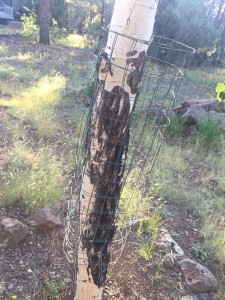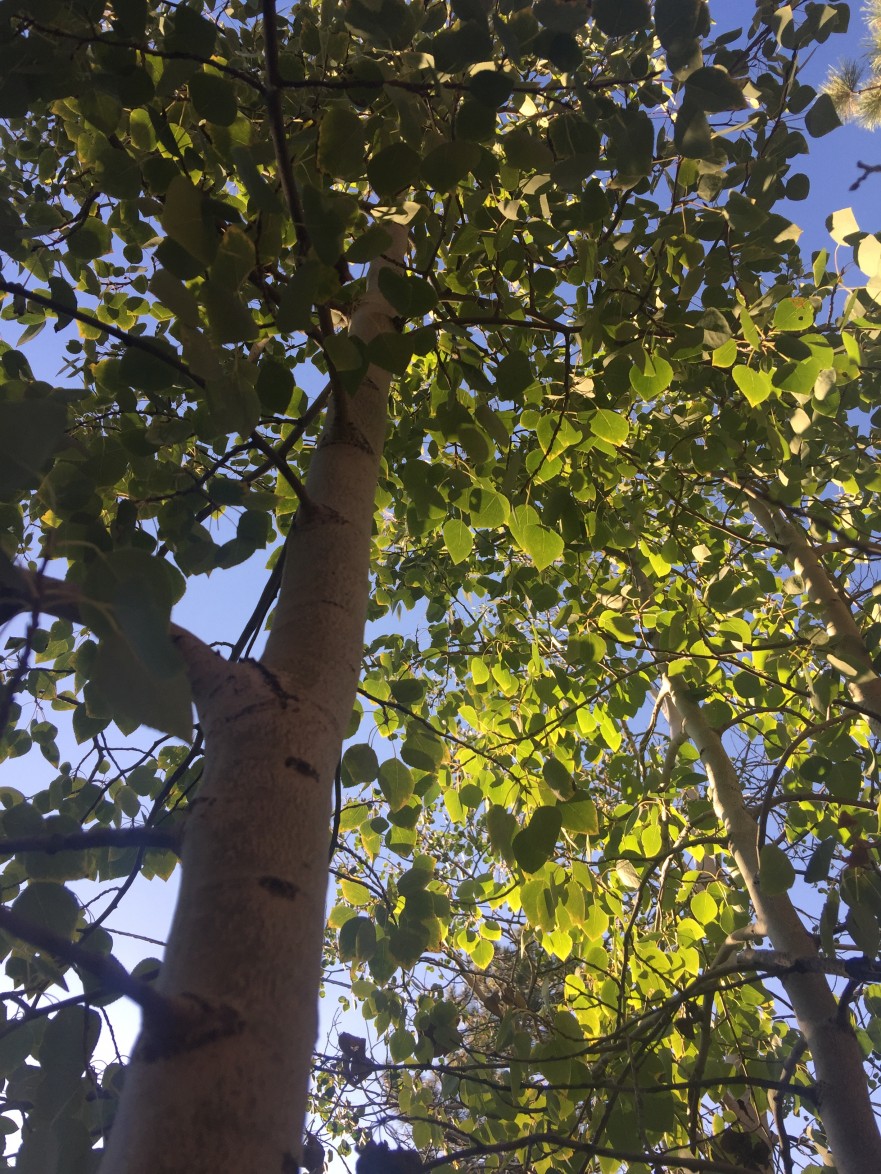I’ve always been obsessed with Aspen trees. When I was younger,they were the “noisy trees” because of the way the wind rattled off of the leaves. When I was in college at NAU, my only science class was an Environmental Science class, complete with field trips all around northern Arizona. My favorite days were the ones spent on the slopes of the San Francisco Peaks, where we would walk and work among the noisy trees. Maybe it was cadence of the leaves, maybe it was their golden hue, or even the way the sun and shade danced on each individual leaf, but they still called to me, still drew me in.
The grad student assigned to our lab would go on to tell us that Aspens are unique and different. I laughed in my head; I’ve known they were just that for years. He would go on to take us on a walking tour of multiple different groves on the slope of Mount Humphries, describing the science behind these trees. A decade (plus some) after that science class, sitting on the back porch of my grandmother’s cabin, I’m still mesmerized by the Aspens that flank it. The grad student’s words come back to me and I realize there is much connection between the trees that have called to me for so long and the profession to which I am called.
—
Aspens’ roots can survive for thousands of years.
Each individual tree is essentially genetically identical to the tree next to it. Trees are connected by a massive root system that can live for thousands of years, even after individual trees themselves die.
The students who fill our classrooms will be lucky enough to experience anywhere between three to four dozen teachers in their educational experience, none of them exactly the same. I feel like this is one advantage to our education system; students are exposed to multiple modalities, philosophies, and opportunities to connect and grow. Teachers are not identical in any way, shape or form, though the systems, processes, and programs they work in may have similarities.
What’s most important is what survives from that exposure to all of those teachers–knowledge and understanding. Knowledge and understanding are at the root of why many of us teach. We want our students to be better people, to be able to comprehend the workings of the world around them, to be part of a well-informed citizenry. This knowledge and understanding survives long past the teacher who teaches it.
Aspens are easily damaged by outside forces.
In Arizona, elk, deer, livestock, and disease pose a significant threat to young, undeveloped Aspen trees. Sometimes these trees are simply trampled on. Other times, older trees’ trunks are used to help elk sharpen their antlers and bark is simply peeled off. This exposes the tree to fungi and disease.
The outside forces that impact our beginning and experienced teachers directly mimic the white-barked saplings. Sometimes, quite simply, our teachers are trampled on by deadlines, meetings, lack of confidence, inability to maintain balance, emails, endless to do lists, inability to say no, a desire to prove themselves and be deemed worthy, and countless other tasks that leave them, like their Aspen counterparts, trampled.
Deliberate acts by others can break down the confidence of any teacher. Aspens do not have a choice in how they react to these outside forces. We do. We can choose to let fungi and disease enter in the forms of anger, comparison, bitterness, and shake us to our roots, or we can choose to allow our internal reserves to sap over the wound and become stronger. As members of the same forest, we have to be able to protect our all of our teachers so we may stand tall. We have to provide barriers and protection to keep and maintain our forest and teaching force in good health.

Aspens are disappearing.
According to Coconino County Forest Service, Aspens could disappear completely from northern Arizona forests within the next 80-200 years with some groves nearing 100% mortality already.
The latest teacher shortage numbers are in, and it seems people who want to teach are disappearing, too. According to The Arizona Daily Star’s summation of a new report by the Arizona School Personnel Administrators Association, at the beginning of September there are
- 6200+ teaching vacancies
- 300 teachers have already resigned this school year
- 109 teachers didn’t report to work by the first day
- 54 teachers abandoned their job
The numbers are an improvement from last year, which saw over 7000 vacancies. Over six thousand vacancies means that there are more than six thousand classrooms where students cannot create the learning and knowledge that can last a lifetime, the root system that is the foundation of our society.
—
I’m snapped out of the trace the clattering of the leaves put on me with a prodding “Mama??” from the baby monitor. I take a glance at those noisy trees and think about the knowledge and meaning that my little one is creating on the daily basis, the root system that will last a lifetime, Then I think about the teachers that he has yet to have, ones that will make his imagination dance like the leaves in the wind do, ones that will be able to capture his attention with music and movement, and ones that can be strong in the face of adversity so they can help me teach him to do the same.










Comments 4
Hi Jen-
Thank you for sharing this post. I love the analogy between the Aspen trees and teaching. As I read this piece I felt like I was right there listening to the trees rustle, likewise I feel the deficit created by teachers abandoning their jobs and the shortage of teachers in AZ. You not only have the courage to teach and create the lasting foundation for AZ students, but you have a son who will be shaped and molded by teachers just like your self.
My district currently has 131 positions posted as open with positions ranging from coaching, to bus drivers, to duty aides, but a large amount of certified positions are in special education, Title I, and intervention programs. Often, the students who are most in need of our help are feeling the teacher shortage most deeply.
The visual of a tree’s growth and root system helped me to consider the progress of a student’s learning and also where their growth is in the elementary years as those ages are near and dear to my heart. Thank you for helping me to consider my student’s growth from a new perspective.
YES! So much of those early elementary years truly set the foundation for future success. So too does middle school set the stage for high school and all of us work together to make sure our students bear excellent fruit!